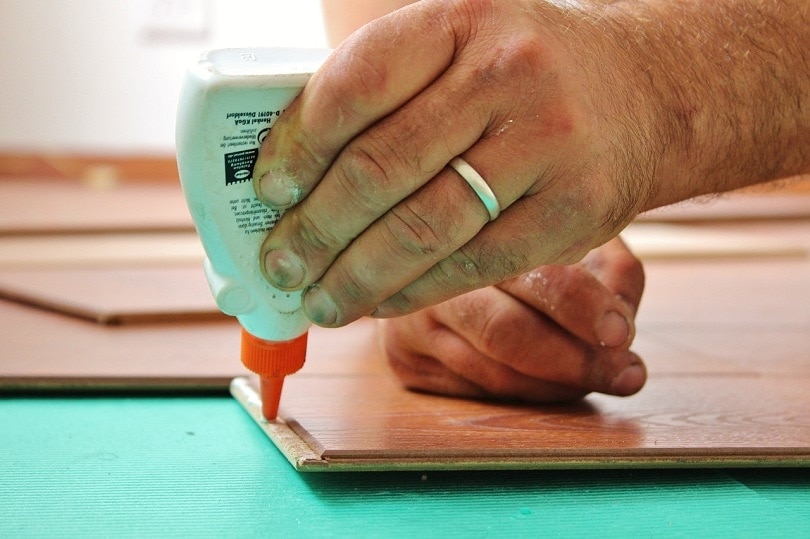5 Types of Wood Glue (With Pictures)
-
Kristin Hitchcock
- Last updated:

When you’re making DIY crafts, wood glue is often a necessary tool, especially if you’re working with wood. However, not all wood glues are made equal. Different sorts of glues will need to be used on different woods.
Therefore, it is vital that you utilize the correct wood glue for your project, otherwise, it may not work at all—or it may even damage the wood.
In this article, we’ll help you determine which wood glue you need for your project. There are five main types, which we will explore below.
The 5 Types of Wood Glue
1. PVA (Polyvinyl Acetate) Wood Glue
When people talk about wood glue, they usually talk about this wood glue. Most people will have this wood glue in their workshop. However, there are several different types of PVA. Many of these have been around since the 20th century, and many have been around since long before most other types.
The most common type is yellow glues. For instance, Titebond falls into the category and is one of the leading wood glues on the market. There are several different types of Titebond wood glue and they all differ in use.
White glue is another type of PVA wood glue. It is completely non-toxic and much easier to clean up. However, it is still strong after it settles.
PVA glue does not absorb stain, so all the excess glue will still be visible after the wood is stained. Therefore, it is often not the best option for the outside of wood furniture and similar locations.
- Works on most types of wood
- Safe to use
- Various kinds
- Does not absorb stain
2. Polyurethane Glue
Polyurethane glue is also another common option. Gorilla Glue is a popular brand name for this glue, which is what most people likely know it as. It forms a very strong bond and can be used on things that are not wood too. For instance, you can also use it on metal, stone, fabric, and ceramics.
However, this glue expands as it sets, which can make it a serious problem for finishing up projects. You should only use it on projects that you have to sand before you’ve finished.
With that said, this glue is water-resistant and is thus great for outdoor furniture as it will not be affected by rain or water.
- Water-resistant
- Very strong bond
- Usable on a variety of surfaces
- Expands as it sets
3. Hide Glue
As the name suggests, this glue is made from animal hide, making it one of the oldest forms of glue available. It is traditionally made into flakes or pellets then is melted down and applied while still warm. As you might imagine, it is a bit more difficult to work with than other options.
However, there are some companies that make a liquid form too.
This formula is one of the strongest, though. There are no additives that neutralize the strength of the glue, which prevents the formula from dissipating. This type of glue is also useful for older furniture, as this is usually the glue that was originally used. Hide glue is also useful for furniture that you may take apart later—you can remove this glue simply by warming it.
Furthermore, this glue can also be stained just like wood, which helps keep the whole project looking even.
- Completely natural
- Easy to remove
- Many forms available
- Can be stained like wood
- More difficult to work with
4. Epoxy Glue

Epoxy is a bit more difficult to use simply because there are two different parts of this glue. One part is the resin, and the other part is the hardener. To turn it into glue, you have to mix both of these parts together.
This glue is mostly utilized for filling gaps in wood for repairs, and it becomes very hard.
This mixture is highly resistant to most elements, including water and heat. It is also resistant to UV light, making it a good option to use outside. While it does make a very strong bond, you cannot use this glue between joints or similar places. Instead, it is most suitable for repairs.
- Very strong bond
- Resistant to many elements
- Great for repairing wood
- Cannot be used for joints
5. CA Glue
CA Glue is more commonly known as Super Glue. However, the generic name for it is Cyanoacrylate, which is usually shortened to CA.
For the most part, this glue can be used for just about everything. However, it is not made for large gluing jobs. Instead, it is best for repairing chipped and cracked wood.
CA glue is made in many different forms, including liquid and gel. Furthermore, it dries up very quickly, which does make it great for smaller applications.
- Widely available
- Can be used on many surfaces
- Dries quickly
- Not great for large jobs
Conclusion
There are several different types of glue that can be used on wood. Not all of these are technical “wood glues.” Instead, some are versatile enough that they can be used on practically anything, including wood.
Not all of these glues are good for every wood project. Some are great for small repairs, while others are best for larger jobs. Some are great for furniture that might need to come apart later, and others aren’t ever going to lose their adhesion. Therefore, the option you choose is largely dependent on what you’re planning on doing with it.
Featured Image Credit: Counselling, Pixabay
Contents
